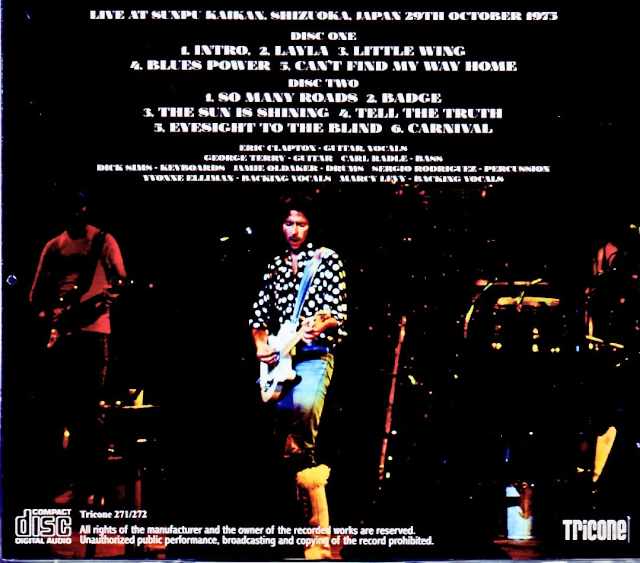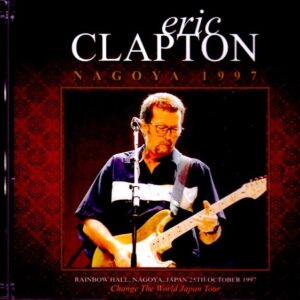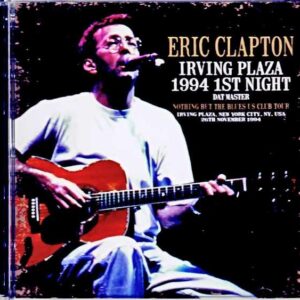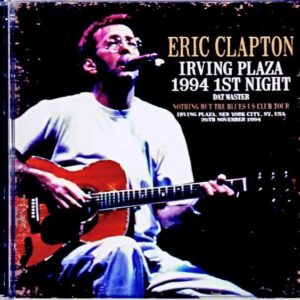Description
The excellent master of the 1975 Shizuoka performance has been upgraded and is back! The title “SHIZUOKA 1975”, which was upgraded to CD in 2015 and sold out in a short time due to its excellent content, is a complete recording of the Shizuoka, Sunpu Kaikan performance on October 29, 1975. It has returned to the original sound source and will be remastered and upgraded for the first time in 10 years! It was recorded from a very good and wide mono audience recording source, the same as the only source that recorded the performance on that day, but this source uses a master dubbed from that master cassette and has also corrected the slight defects that existed by Graf Zeppelin. This master uses a different source dubbed from the master, as the cheers before and after the show are recorded longer, and the cheers before the encore are recorded shorter. However, compared to the previously released version with amplified mid-low and treble, the entire version is recorded with natural sound quality, and the phase shift, which was right-leaning throughout the entire version, has been corrected, and the momentary sound cuts in one channel that were scattered in places, the right channel from Blues Power 1:50 and the left channel from around Badge 6:04 have been appropriately corrected, making it the most listenable upgraded version ever. One of the selling points of this year’s Japan tour is that each performance played its own rare blues. As The Years Go Passing By (Albert King’s number) on the second day of the Osaka performance on the 23rd was also extremely rare, but the Shizuoka performance was notable for playing So Many Roads (Otis Rush’s number), which was the only time Clapton played in his live performance history. As symbolized by this, this year’s Japan tour was an attractive tour in which the set list was different for each performance. Please enjoy this work, which contains the best version of the master, which is considered one of the representative sound sources of the 1975 Japan tour, due to the content of the concert, high quality and wonderful sound quality. The truth of the performance that cleared the previous year’s stigma and engraved Clapton’s status in Japanese rock history The performance in 1974, the previous year, which was his first visit to Japan, was misunderstood and misrepresented because he was drunk and wanted to survive the tour in a state of sickness from drug addiction (Clapton did not play many solos and left them to second guitarist George Terry, but in fact, when listening to the sound source that appeared later, Clapton played quite a lot). I don’t think Clapton himself knew about that evaluation, but even though he was still drinking heavily, Clapton’s appearance when he set foot on Japanese soil again was fearless. This was his second visit to Japan, which came amid his miraculous first visit to Japan the previous year, and his huge popularity, having been voted number one in the guitarist category in the music magazine Music Life’s popularity poll that same year. Shizuoka fans were excited and waiting, thinking, “Clapton is coming to Shizuoka! He must be full of energy as it’s his first time in the country!” It’s no exaggeration to say that Clapton’s huge popularity in Japan to this day was sparked by this tour. It was here that he made his true comeback. Let’s take a look back at Clapton’s activities in 1975. (*”-” indicates previously released titles) <April 1, 1975: Album “THERE’S ONE IN EVERY CROWD” released>・April 7-28, 1975: Oceania tour・June 14-August 30, 1975: US tour・September 1975: Off・October-November 1975: Second Japan tour October 22, 1975 – Osaka Festival Hall ← “Osaka 1975 1st Night (4CD)” October 23, 1975 – Osaka Festival Hall ← “Osaka 1975 2nd Night (2CD)” October 24, 1975 Kyoto Kaikan First Hall October 27, 1975 – Kitakyushu City General Gymnasium October 29th, 1975 – Shizuoka Prefecture Sunpu Kaikan ←★【This Album】★”SHIZUOKA 1975″November 1st, 1975 – Nippon Budokan ←”BUDOKAN 1975 1ST NIGHT: Unreleased Master(2CD)”, “Budokan 1975 1st Night(2CD)”November 2nd, 1975 – Nippon Budokan ←”Lord Have Mercy(2CD)”If you look at this, you can see that it was a year filled with touring, but just like the previous year, they organized a Japan tour after the American tour, which is a major market. That shows how important Japan was to them. Clapton’s look on this day was probably with long hair that reached his shoulders, slightly permed. He had a thin beard and a handsome face. His slim build and long legs looked great in jeans. When he appeared holding a brand new blonde-finished Fender Telecaster that a friend had given him before rehearsing in the Bahamas for the Japan tour, he was a superstar who had been given two gifts by heaven. The amazing stage started with the famous song Layla! A set list of playing! Time slip to the Sumpu Kaikan on the day! What was surprising was the set list that brought Layla to the opening. The audience’s excitement was incredible, especially since the previous year’s performance started with a quiet acoustic number. That’s how shocking the opening was. Then, for the second song, he played Jimi Hendrix’s famous song Little Wing. The audience at the venue must have been moved by this series of Dominos numbers, which is unique to the Shizuoka performance. These two opening songs are a very majestic performance. Little Wing in particular is a performance that maximizes the band’s potential at that time. From then on, Clapton used the blonde-finished Telecaster that he had purchased new at the time throughout the entire performance. He uses a slightly fat and lustrous tone to play long tones, and expresses a sense of scale with a relaxed and laid-back play. In the popular slow blues song So Many Roads, you can enjoy Clapton’s blues guitar in detail. “There are many roads in life, and many trains to ride,” is how Clapton speaks through his guitar. And yet, Clapton’s playing here is very aggressive. He hits off a series of amazing phrases. It’s one of the best performances in Japan. Before the next song, Badge, Clapton introduces the song title with “Badge! Badge!”, which is interesting. In the middle, Clapton uses the wah-wah to play a super long solo. The super guitarist is here. This song usually develops by repeating the bridge arpeggio part twice, but on this day, Sergio Rodriguez’s percussion solo and Jamie Oldaker’s drum solo were inserted endlessly, making it a raging performance that lasted 14 minutes. It is a very rare live take. Clapton also plays the second solo after that. At the end, he and George Terry create a twin lead composition to liven up the performance. It is very worth listening to. Tell The Truth, which closed the regular set, is also a very groovy performance. The postlude solo is exclusively left to George Terry’s slide play. For Clapton, since he gave the rhythm section the glory in Badge, he may have been concerned about letting Terry have the glory here. This is proof that this band was so united for Clapton. Looking at it this way, even though the number of songs in the set is small, each song is long and slow, yet the performance is heated. The fans who were there that day must have been ecstatic. The audience was also excited when the female vocalists Yvonne Elliman and Marcie Levy (who Clapton introduced as “Levy” at that time) were featured. In “Can’t Find My Way Home,” Elliman borrowed Clapton’s Blackie Strat and played it (it was also fun to hear him play the intro to Jimi Hendrix’s Purple Haze before the song). Clapton, who had once left the stage, reappeared for the final chorus part. You can also hear the rare scene of him adding a chorus. Before the song, Levy calls out “Moshimoshi!” in Japanese, but it seems that he saw a Japanese person making a phone call somewhere and misunderstood “moshimoshi” as a general greeting for Japanese people. This is also interesting. In the encore, they played Eyesight To The Blind, which was sung in the appearance scene of The Who’s movie “TOMMY,” which was also released in Japan at the time. This number was not included in the set at the local performances in the first half of the tour. And the medley was performed on the number Carnival, which had not yet been officially recorded at this point (later included in the album “NO REASON TO CRY”). This number was also performed on the first day of the Osaka performance, but this medley can only be heard at this Shizuoka performance. Moreover, it includes Clapton’s solo, which was not included in the later studio version. The set list was composed entirely of electric instruments, which was not present the previous year. There was no drunken MC. Here is Clapton’s original appearance playing the guitar. This is one of the reasons why the 1975 tour is so popular. Clapton, who was 30 years old at the peak of his popularity, came to Japan for the second time 50 years ago, half a century ago, and the audience welcomed him with open arms, and Clapton showed off his sharp play in response. This Shizuoka performance was full of the “special” brilliance of Clapton’s entire career. Very good mono Aud recording. I have made some appropriate corrections to the phase shift that was leaning to the right throughout the recording, the momentary sound cut-outs in one channel that were heard in places, and the volume reductions in the right channel from around Blues Power 1:50 and the left channel from around Badge 6:04.The sound was good enough at the master tape stage that there was no need to adjust the EQ, so I barely made any. Sunpu Kaikan, Shizuoka, Japan 29th October 1975 TRULY PERFECT SOUND(from Original Masters) UPGRADE Disc 1(41:01) 1. Intro. 2. Layla 3. Little Wing 4. Blues Power 5. Can’t Find My Way Home Disc 2(69:05) 1. So Many Roads 2. Badge 3. The Sun Is Shining 4. Tell The Truth 5. Eyesight To The Blind 6. Carnival Eric Clapton – Guitar, Vocals George Terry – Guitar Carl Radle – Bass Dick Sims – Keyboards Jamie Oldaker – Drums Sergio Rodriguez – Percussion Yvonne Elliman – Backing Vocals Marcy Levy – Backing Vocals







Reviews
There are no reviews yet.